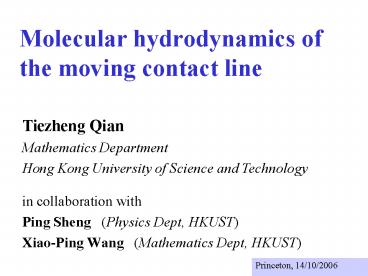Molecular hydrodynamics of the moving contact line - PowerPoint PPT Presentation
Title:
Molecular hydrodynamics of the moving contact line
Description:
Advection-diffusion equation. First-order equation for relaxation of (B.C. ... advection-diffusion equation. 1st order relaxational equation. Summary: ... – PowerPoint PPT presentation
Number of Views:35
Avg rating:3.0/5.0
Title: Molecular hydrodynamics of the moving contact line
1
Molecular hydrodynamics of the moving contact
line
Tiezheng Qian Mathematics Department Hong Kong
University of Science and Technology
- in collaboration with
- Ping Sheng (Physics Dept, HKUST)
- Xiao-Ping Wang (Mathematics Dept, HKUST)
Princeton, 14/10/2006
2
?
No-Slip Boundary Condition, A Paradigm
3
from Navier Boundary Conditionto No-Slip
Boundary Condition
(1823)
shear rate at solid surface
- slip length, from nano- to micrometer
- Practically, no slip in macroscopic flows
4
Youngs equation
5
velocity discontinuity and diverging stress at
the MCL
6
No-Slip Boundary Condition ?
G. I. Taylor Hua Scriven E.B. Dussan S.H.
Davis L.M. Hocking P.G. de Gennes Koplik,
Banavar, Willemsen Thompson Robbins
- 1. Apparent Violation seen from
- the moving/slipping contact line
- 2. Infinite Energy Dissipation
- (unphysical singularity)
No-slip B.C. breaks down !
- Nature of the true B.C. ?
- (microscopic slipping mechanism)
- If slip occurs within a length scale S in the
vicinity of the contact line, then what is the
magnitude of S ?
Qian, Wang Sheng, PRE 68, 016306 (2003) Ren
E, preprint
Qian, Wang Sheng, PRL 93, 094501 (2004)
7
Dussan and Davis, J. Fluid Mech. 65, 71-95 (1974)
- Incompressible Newtonian fluid
- Smooth rigid solid walls
- Impenetrable fluid-fluid interface
- No-slip boundary condition
Stress singularity the tangential force exerted
by the fluid on the solid surface is infinite.
Not even Herakles could sink a solid ! by Huh
and Scriven (1971).
a) To construct a continuum hydrodynamic model
by removing conditions (3) and (4). b) To make
comparison with molecular dynamics simulations
8
Molecular dynamics simulationsfor two-phase
Couette flow
- Fluid-fluid molecular interactions
- Fluid-solid molecular interactions
- Densities (liquid)
- Solid wall structure (fcc)
- Temperature
- System size
- Speed of the moving walls
9
boundary layer
tangential momentum transport
Stress from the rate of tangential momentum
transport per unit area
10
The Generalized Navier boundary condition
The stress in the immiscible two-phase fluid
viscous part
non-viscous part
interfacial force
GNBC from continuum deduction
static Young component subtracted gtgtgt
uncompensated Young stress
A tangential force arising from the deviation
from Youngs equation
11
nonviscous part
viscous part
12
Continuum Hydrodynamic Model
- Cahn-Hilliard (Landau) free energy functional
- Navier-Stokes equation
- Generalized Navier Boudary Condition (B.C.)
- Advection-diffusion equation
- First-order equation for relaxation of
(B.C.)
supplemented with
incompressibility
impermeability B.C.
impermeability B.C.
13
supplemented with
14
GNBC an equation of tangential force balance
15
Dussan and Davis, JFM 65, 71-95 (1974)
- Incompressible Newtonian fluid
- Smooth rigid solid walls
- Impenetrable fluid-fluid interface
- No-slip boundary condition
Condition (3) gtgtgt Diffusion across the
fluid-fluid interface Seppecher, Jacqmin,
Chen---Jasnow---Vinals, Pismen---Pomeau,
Briant---Yeomans Condition (4) gtgtgt GNBC
Stress singularity, i.e., infinite tangential
force exerted by the fluid on the solid surface,
is removed.
16
molecular positions projected onto the xz plane
Symmetric Couette flow
Asymmetric Couette flow
Diffusion versus Slip in MD
17
near-total slip at moving CL
Symmetric Couette flow V0.25 H13.6
no slip
18
profiles at different z levels
symmetric Couette flow V0.25 H13.6
asymmetricCCouette flow V0.20 H13.6
19
Power-law decay of partial slip away from the
MCL, observed in driven cavity flows as well.
20
The continuum hydrodynamic model for the moving
contact line
A Cahn-Hilliard Navier-Stokes system supplemented
with the Generalized Navier boundary
condition, first uncovered from molecular
dynamics simulations Continuum predictions in
agreement with MD results.
Now derived from the principle of minimum energy
dissipation, for irreversible thermodynamic
processes (linear response, Onsager 1931).
Qian, Wang, Sheng, J. Fluid Mech. 564, 333-360
(2006).
21
Onsagers principle for one-variable irreversible
processes
Langevin equation
Fokker-Plank equation for probability density
Transition probability
The most probable course derived from minimizing
Euler-Lagrange equation
22
The principle of minimum energy dissipation
(Onsager 1931)
Balance of the viscous force and the elastic
force from a variational principle
dissipation-function, positive definite and
quadratic in the rates, half the rate of energy
dissipation
rate of change of the free energy
23
Dissipation function (half the total rate of
energy dissipation)
Rate of change of the free energy
kinematic transport of
continuity equation for
impermeability B.C.
24
Minimizing
yields
with respect to the rates
Stokes equation
GNBC
advection-diffusion equation
1st order relaxational equation
25
Summary
- Moving contact line calls for a slip boundary
condition. - The generalized Navier boundary condition (GNBC)
is derived for the immiscible two-phase flows
from the principle of minimum energy dissipation
(entropy production) by taking into account the
fluid-solid interfacial dissipation. - Landaus free energy Onsagers linear
dissipative response. - Predictions from the hydrodynamic model are in
excellent agreement with the full MD simulation
results. - Unreasonable effectiveness of a continuum
model.
- Landau-Lifshitz-Gilbert theory for micromagnets
- Ginzburg-Landau (or BdG) theory for
superconductors - Landau-de Gennes theory for nematic liquid
crystals































